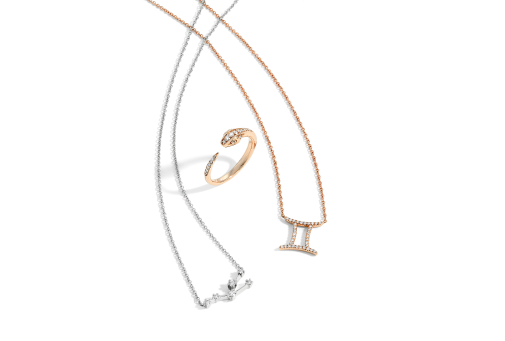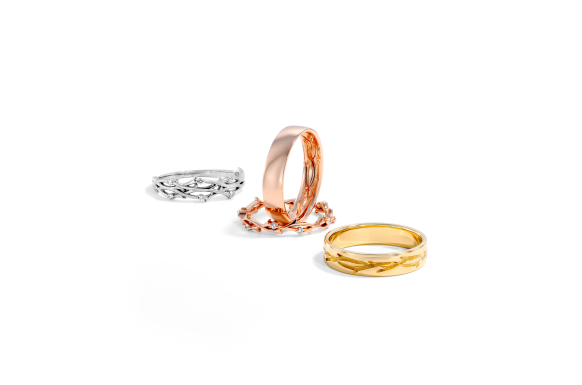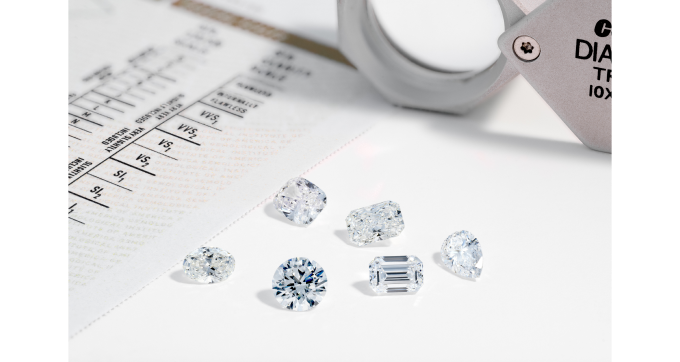Diamond shape is probably one of the first things you think about when imagining your perfect ring. With so many diamond shapes to choose from, it takes time and consideration to select the diamond shape that you'll wear for a lifetime.
Each shape has its own character and properties. They are also used and set in jewelry in different ways.
Understanding the shapes that are available makes it so much easier to find the right stone. So here's your crib sheet for 16 classic diamond shapes names that never go out of style!
What is diamond shape?
Diamond shape is the outline shape of the stone. It's what the diamond looks like if you were looking at it from the top down. When you read the names of diamond shapes, many (like “heart” or “oval”) are actually shapes, so you immediately have an idea of what the diamond will look like. Other diamond shapes are traditional names or named afte the diamond cutter who created them.
Shape is not the same as cut
Its easy to confuse diamond shape and cut but cut refers to the arrangement of the individual facets that make up the stone.
16 diamond shapes names
Here are 16 of the most common and popular diamond shapes available today. Use this list to help you find your perfect ring:
Classic shapes that never go out of style
These are world-renowned classic diamond shapes that ae usually used as center stones
1. Asscher
Asscher diamonds are square-cut. The master diamond cutter Joseph Asscher invented this lively and distinctive design in the early 20th century.
What are the characteristics of the Asscher shape?
The bold features of this diamond shape add fire and drama:
- square shape
- small table
- large step facet
- wide cut corners
- high crown
- deep pavilion
These features give the Asscher shape a wide windmill reflection. The mesmerizing concentric square patterns within the stone are known as the "House of Mirrors". This impressive shape looks its best in a solitaire setting.
2. Cushion
Cushion-shaped diamonds have a squarish, pillow shape. They are a modernized version of the antique Old Mine cut (see below). Thanks to innovative cutting techniques, contemporary cushion-cut stones have outstanding symmetry and proportions.
What are the characteristics of the Cushion shape?
A cushion shape often has less brilliance than other diamond shapes, but they beautifully retain and separate light. Key features include:
- squarish or rectangular shape
- gently rounded edges and corners
- length to width ratio of less than 1.05
- small to medium-sized cutlet
With expert cutting a cushion diamond can have a dazzling "crushed ice" look. They have lots of old-world charm in antique or vintage settings.
3. Heart
The full name of a heart-shaped diamond is “Heart-Shaped Modified Brilliant". It was originally modified from a sound brilliant and has lots of sparkle. This classic fancy shape is popular for engagement rings as you are literally giving your heart to the one you love!
What are the characteristics of the Heart shape?
- heart-shaped
- an ideal length-to-width ratio of 0.85 to 1.00
- symmetrical appearance
- heart lobes have equal height and breadth
- sharp and distinct cleft
Selecting a heart diamond is a down to personal taste as the ratios can vary widely. The depth of a heart-shaped diamond can affect the appearance of its size and brilliance. Despite being very distinctive, heart stones work with most settings.
4. Emerald
Emerald diamonds are step-cut, which gives them a classic mirror effect. and resemble a staircase, hence the name step-cut. It is a classy and classic shape that imparts understated elegance to its wearer.
What are the characteristics of the Emerald shape?
- square or rectangular outline
- open, large facets
- a typical length-to-width ratio of 1.5
The shape of this diamond is less brilliant than other diamond shapes. It can also show up color present in the diamond. But emerald takes advantage of the crystalline structure of diamond so it can be well-cut.
5. Oval
The oval is a modification of the sound brilliant diamond shape. Its smooth and pleasing contours flatter any hand. Lazare Kaplan, a relative of the famous gemologist Marcel Tolkowsky, invented it in the 1960s.
What are the characteristics of the Oval shape?
- elongated fancy rounded shape
- a full body
- even well-rounded ends
- a length-to-width ratio of 1.33-1.55
This elongated shape looks amazing in a pong setting as it lets the greatest amount of light into the gem. If the proportions are not optimal, oval diamonds can have a dark bowtie effect, but they still look gorgeous with a clear and colorless stone.
6. Marquise
This diamond shape is fabled to have been an invention of the Sun King, Louis XIV of France. Strangely it this diamond is meant to be an outline of the shape of the mouth of the Marquise of Pompadour! It is ovate with pointed ends and is a popular choice of diamond that punches well above its carat weight.
What are the characteristics of the Marquise shape?
- football-shaped
- a length-to-width ratio of 1.75-2.25
- best depth: 58-65.4 percent
- best table: 52-65.4 percent
Proportions are key to getting a Marquise diamond right. Misalignments in the stone can cause a bowtie. If the girdle of a Marquis is too thin, the stone becomes vulnerable to damage. If it is too thick, it's awkward to set effectively.
7. Pear
The pear-shaped modified brilliant combines the features of round and marquise diamonds. This classic shape, made famous by Elizabeth Taylor, never goes out of style. You wear it with the point towards the fingernail.
What are the characteristics of the Pear shape?
- teardrop shape
- half of the stone is round or oval
- half of the stone is Marquise, tapering to a point
- well-shaped head
- even shoulders
- an optimal length-to-width ratio is between 1.45 and 1.70
The pear shape can be pleasing across a broad range of dimensions. You can also use small pear stones, oriented on their sides, as striking accent stones. It is usually selected according to personal taste. Poor proportions in a pear diamond can affect durability and misalignment of facets can create a bowtie effect.
8. Princess
Betzalel Ambar of the Ambar Company in Los Angeles created this smart square-shaped design. Despite its striking angles, this diamond shape retains a large amount of the rough crystal weight, making it great value.
What are the characteristics of the Princess shape?
- square shape
- sharp, squared-off corners
- a length to width ratio less than 1.05
- depth of 58-76 percent
- table of 58-77 percent
When well-cut, this angular shape can achieve a lot of brilliance. Good polish and symmetry in this stone also provides an uplift in appearance for lower grade diamonds. Care has to be taken with setting a princess diamond. This is because the sharp corners and angles can be chipped or cracked.
9. Radiant
A radiant shape diamond is a square or rectangular stone with cut-corners. It was originally propietary but is now in the public domain. Though it is less than 20 years old, the radiant continues to be an exclusive and alluring choice. It beautifully combines vintage elements with contemporary detailing.
What are the characteristics of the Radiant shape?
- rectangular or square shape
- dazzling cut
- cut coners
- facet arrangement intensifies color
- a length to width ratio of 1.2 to 1.3
- depth of 58-69 percent
- table of 58-69 percent
This diamond shape is popular as a center stone in three-stone rings. The specific proportions of this ring affect its surface area and brilliance. Facet misalignment can cause the appearance of a bowtie effect.
10. Round
The round brilliant diamond shape is the world's most popular diamond shape and widely used in engagement rings. Over 75 percent of diamonds sold are round brilliants. In the early 20th century, Marcel Tolkowsky devised the characteristics of this classic diamond shape.
What are the characteristics of the Round shape?
- circular shape
- table size range is 53-57 percent of the stone’s diameter
- no cutlet or very small cutlet
- a depth of 59-62.5 percent
- a table of percent
The round brilliant set the standard for the ideal characteristics of a diamond, which are used for grading diamonds today. It is extremely versatile and can be set in a wide range of types and styles of jewelry.
Antique and vintage diamond shapes, names of cuts
These earlier diamond shapes are the predecessors of popular contemporary designs and are still popular in antique and vintage engagement ring designs:
11. Old European cut
The old European cut is a round diamond shape that gave rise to the modern round brilliant cut. It was a handcrafted shape that was prevalent in the 18th and 19th centuries. Its distinctive cuts are charming but don't have the brilliance of modern diamond shapes.
What are the characteristics of the Old European shape?
- hand-worked
- follows the rough diamond shape
- deep heavy cuts
- open cutlet
- varying facet positioning and angles
- characterful imperfections
Old European-shaped diamonds may appear coarse or flawed when compared to contemporary standards. The proportions are not perfect - but this makes them beautiful.
12. Old Mine cut
The Old Mine cut is another predecessor of the round brilliant and contains some of its features. Old mine diamonds are more square or cushion cut than round. It was popular between the 17th and late 19th centuries. Like other antique diamond shapes old mine diamonds were hand cut.
What are the characteristics of the Old Mine shape?
- rounded square or cushion shape
- hand-cut and polished
- cuts are close to the shape of the rough
- imperfect proportions and symmetry
- large facets
- prominent cutlet
Despite its imperfections, this old-world diamond shape has lots of character and charm. In soft candlelight, this diamond shape would emit a soft glow.
13. Rose
This is one of the oldest antique diamond shapes and has endured from the 16th century to the present day. It differs from most diamond shapes with its domed round shape covered in individual triangular facets.
What are the characteristics of the Rose shape?
- round oval or pear shaped
- domed surface
- flat bottom
- triangular facets
- cuts follow the shape of the rough stone
- tiers of facets arranged in multiples of six
There has been a recent revival of interest in the rose shape. It is versatile and is appealing in a variety of jewelry types and settings.
Accent stone names
You can enhance the appearance of a center stone by adding accent or side stones. These smaller gems sit on either side of the center stone and produce an uplift in the brilliance of the ring. Here the most popular accent stone shapes:
14. Baguette
These are small rectangular diamonds that are straight or tapered to a rhomboidal shape. They are named after the long loaves of French Bread. Baguette diamonds first became popular during the Art déco and Art nouveau periods. This clean, smart, step-cut shape can accent diamond rings in a variety of ways.
What are the characteristics of the Baguette shape?
- rectangular
- straight or tapered
- straight
- step-cut
- high clarity
Baguette diamonds are usually set in channel or prong settings. When the individual stones are well-selected and polished they have a classic, understated beauty.
15. Round
Small round brilliants are a classic accent that creates a stunning effect as single side stones or in dazzling clusters. They can be used in a variety of ways to customize a ring. These stones range in size from the tiny melee diamonds of pave to larger brilliant side stones of 0.2 carats or less.
16. Pear
Conclusion
You can use any one of these gorgeous diamond shapes to make a beautiful ring with enduing appeal. We hope you have found a shape you love!
Search for the perfect diamond among thousands of loose high-quality graded and fully-appraised natural, lab-created diamond and Moissanite stones available in the leading shapes. You are only a few clicks away from finding your forever stone.






